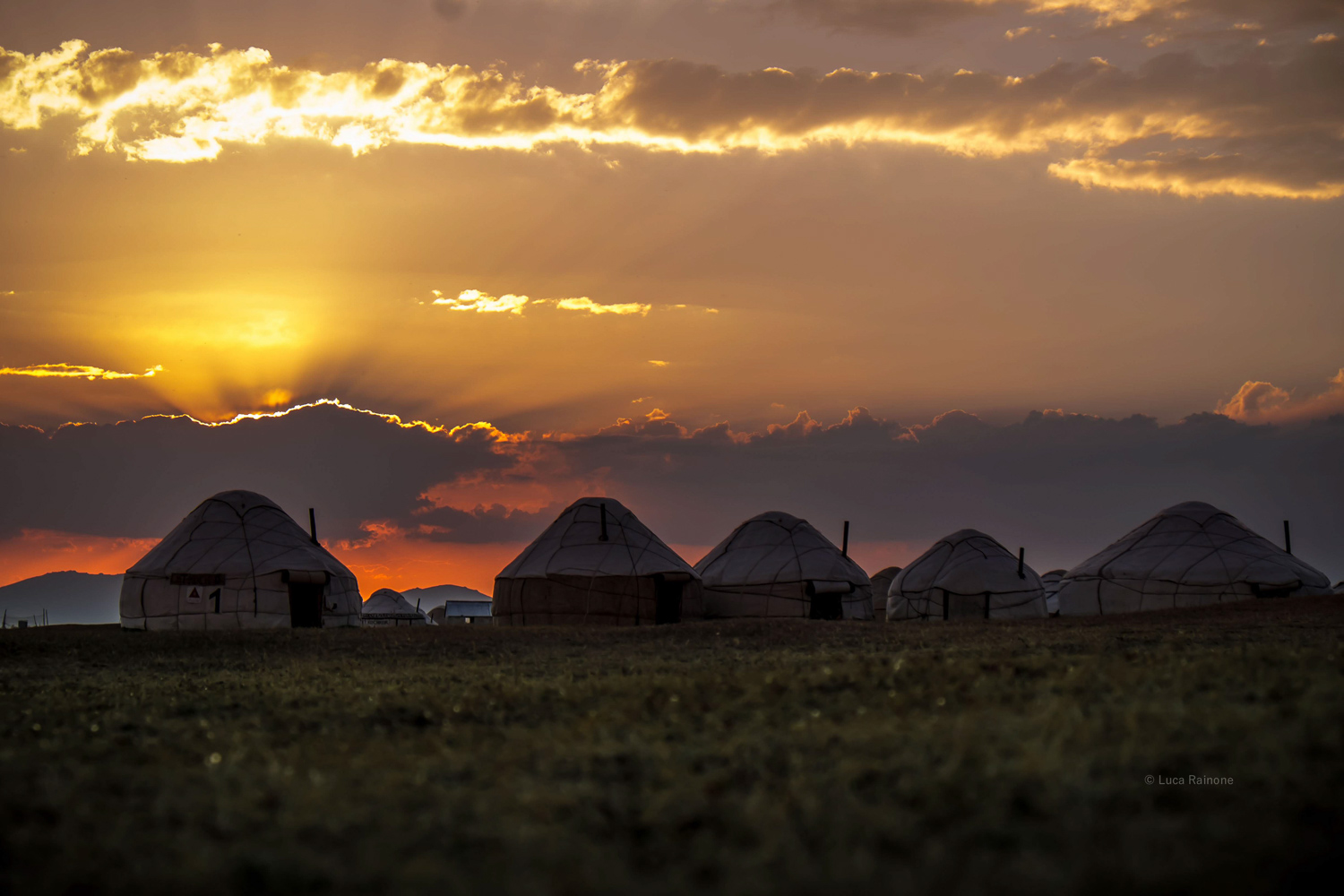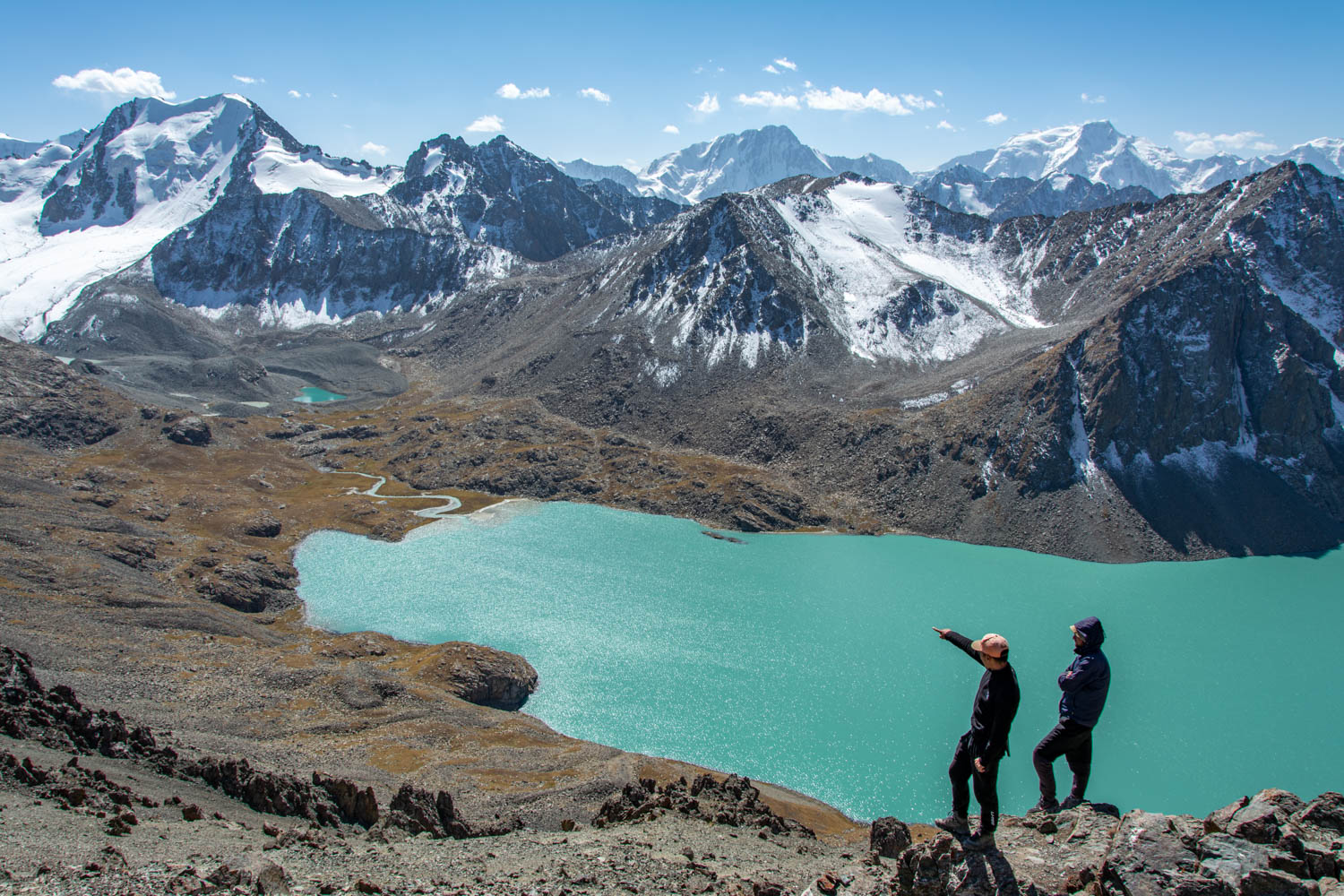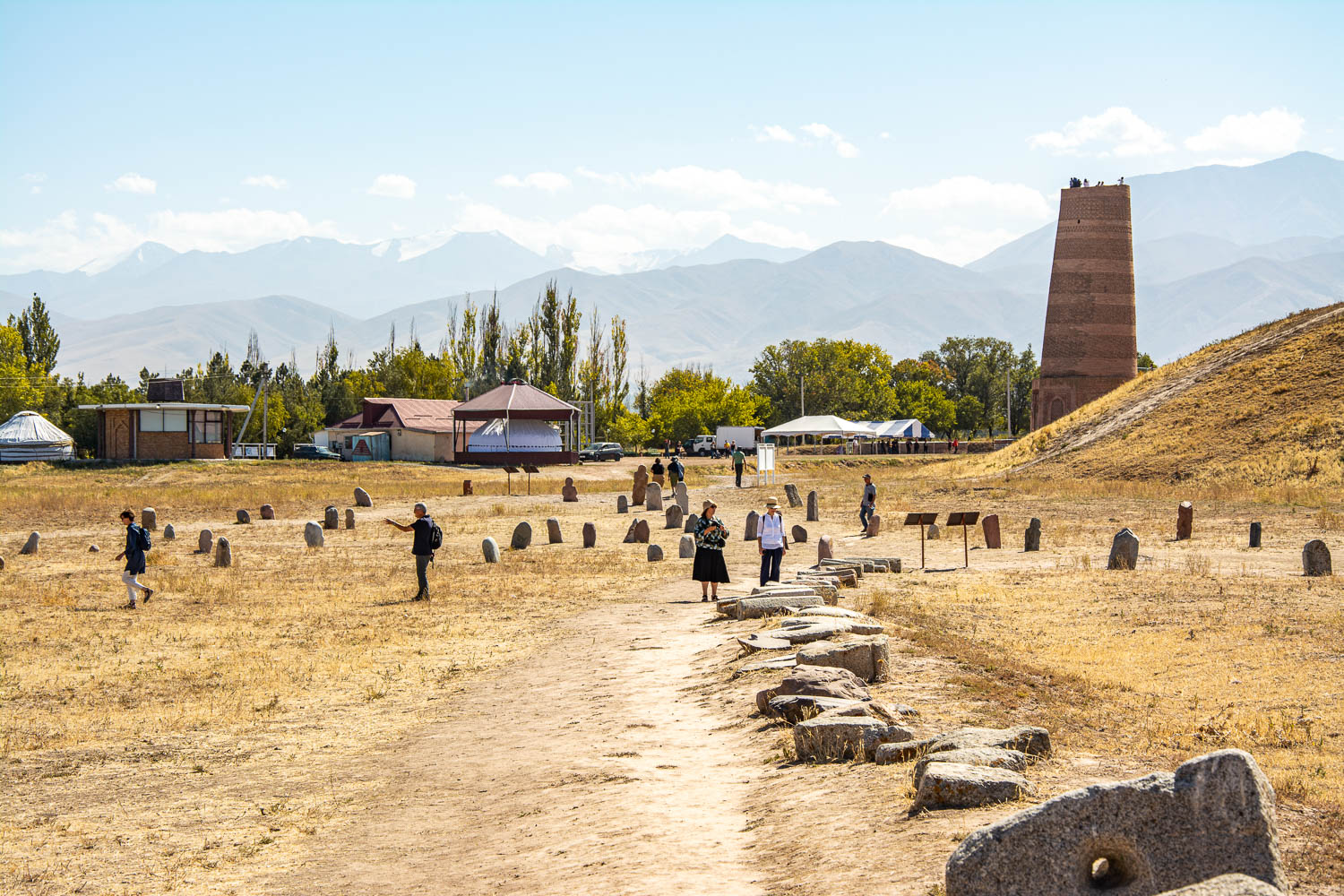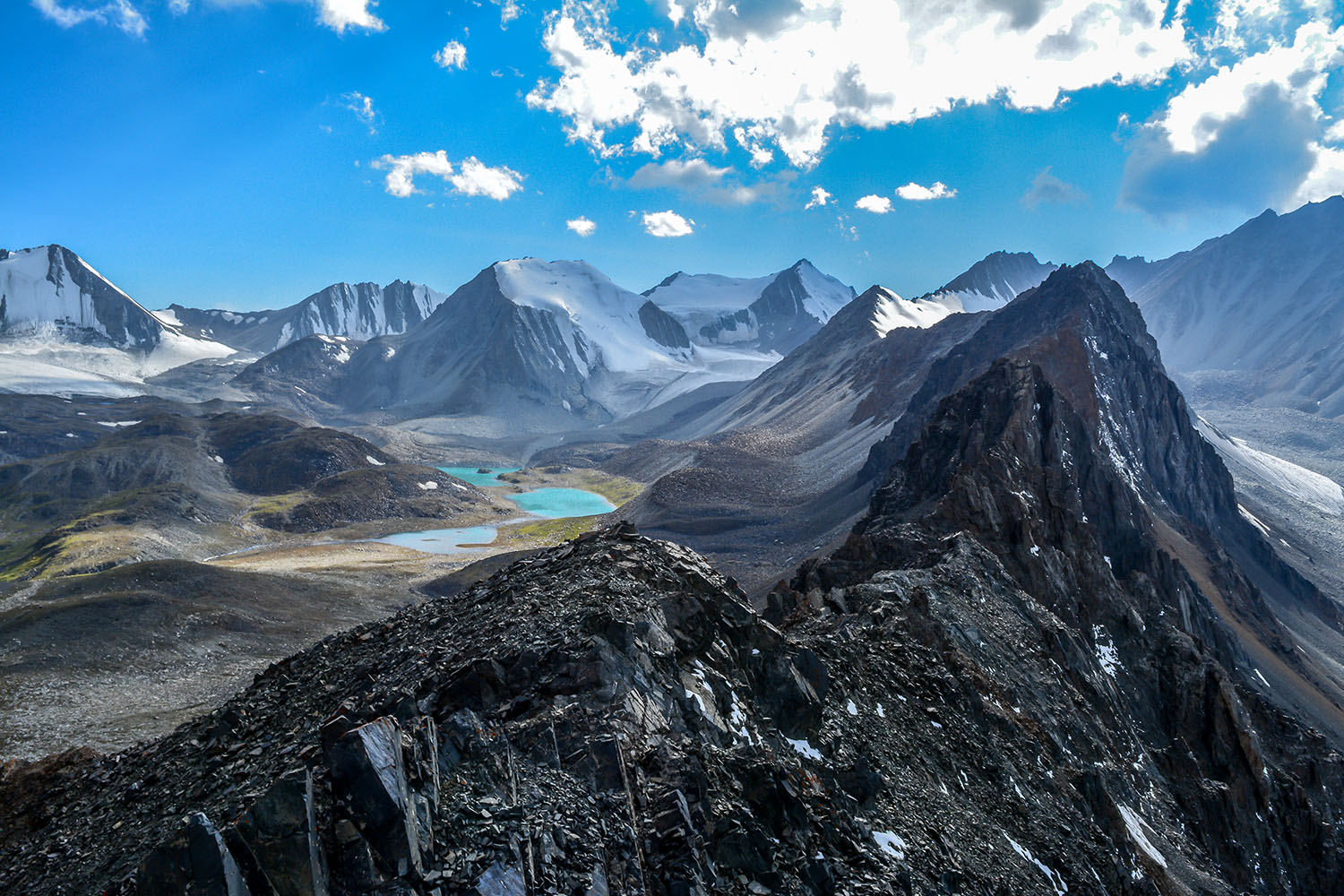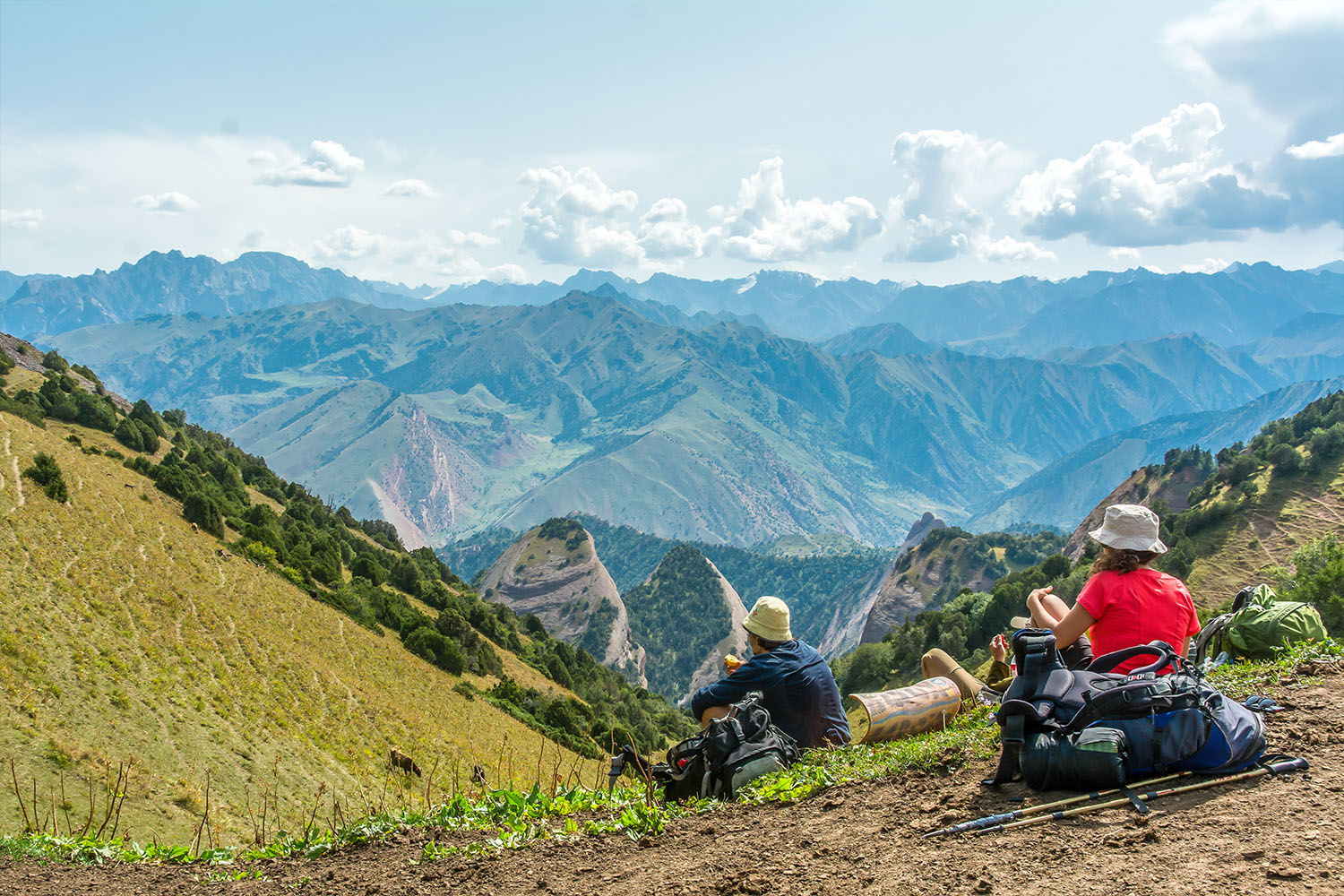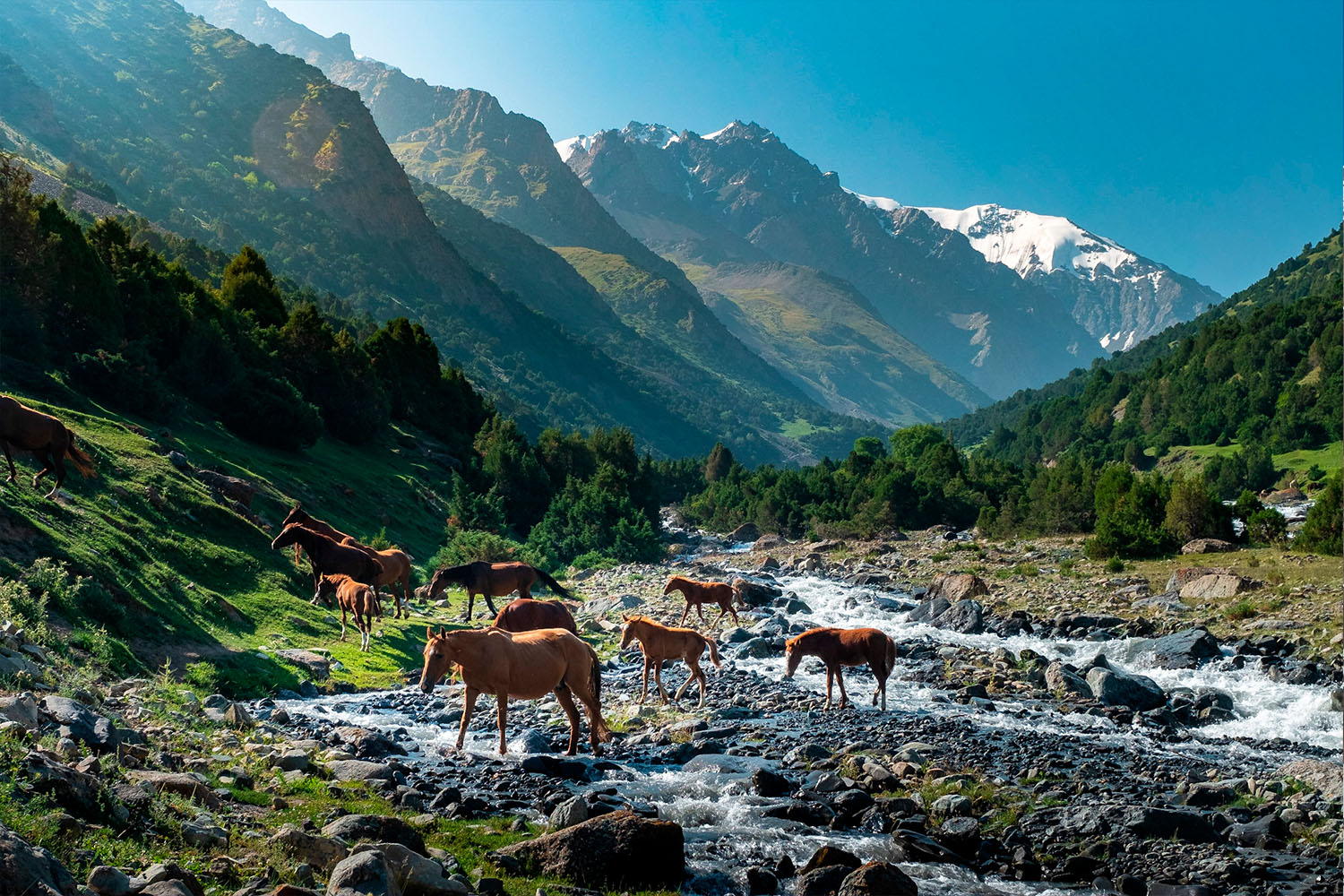Embark on an extraordinary 14-day adventure with the “Best of Kyrgyzstan Trek”, guiding you through the heart of Central Asia’s most breathtaking landscapes. This epic Kyrgyzstan trekking journey is designed to immerse you in the raw beauty of both the Tian Shan and Pamir-Alay Mountains, offering an unparalleled exploration of pristine natural wonders, cultural richness, and the spirit of nomadic traditions. Experience the adventure of a lifetime, where every day unfolds a new chapter of awe-inspiring vistas and genuine local hospitality.
The “Best of Kyrgyzstan Trek” masterfully combines three distinctive expeditions into one seamless journey:
- The enchanting Best of Alay Mountains trek, nestled in the heart of the Pamir-Alay range, offers a gateway to high-altitude wonders and serene landscapes.
- The Ala Kul Lake Trek, a journey through the majestic Tian Shan Mountains, unveils crystal-clear waters set against a backdrop of towering peaks.
- Bridging these treks is a three-day overland voyage to the alpine marvel that is Lake Song Kol. This segment promises a serene interlude, with panoramic views of majestic alpine scenery that serve as a breathtaking connector between the treks.
Detailed Tour information about the Best of Kyrgyzstan Trek (14 days)
Destination: Tian Shan and Pamir Alay Mountains, Kyrgyzstan
Itinerary: Bishkek – Karakol – Ala Kul – Issyk Kul – Song Kol – Kazarman – Osh city – Alay Mountains – Osh
Duration: 14 days / 13 nights
Accommodation: 2-night in tents / 6-night in yurt camps / 5-night in guesthouses
Trekking distance: 104 km
Max Elevation: 4,306 meters
Min Elevation: 2,186 meters
Months Possible: June – early September
Difficulty: Moderate to Difficult
Start point: Bishkek city
End Point: Osh city
Map of the Best of Kyrgyzstan Trek
Blue line – Car road Red line – Trekking road
DAY 1. BISHKEK – KARAKOL VIA BURANA TOWER
Driving distance: 7-8 hours
After breakfast, meet the driver at your hotel to set off for a 7-hour-long journey to Karakol. Along the way stop at one of Kyrgyzstan’s oldest sights, the Burana Tower, and learn about its ancient architecture – rare in nomadic culture. The territory where the tower is located was once called Balasagyn town. This town had strategic meaning for the Great Silk Road. Here you will see a small museum with exhibits found during past excavations, providing more details about this ancient settlement, including a collection of “Balbals” – Turkic grave marks. After, continue driving to Karakol city via Issyk Kul Lake, the second-largest alpine lake in the world after Titicaca in South America. Its length reaches 182 km and width is 58 km, and the maximum depth is up to 668 meters. If we arrive early, we can take a short sightseeing tour in Karakol city by visiting the wooden Dungan mosques and Russian Orthodox churches if we have time. Dinner and overnight stay in Karakol city.
Accommodation: Guesthouse
Meals included: Dinner
Facilities: Wi-fi, electricity, hot shower, and western-style toilets
Burana Tower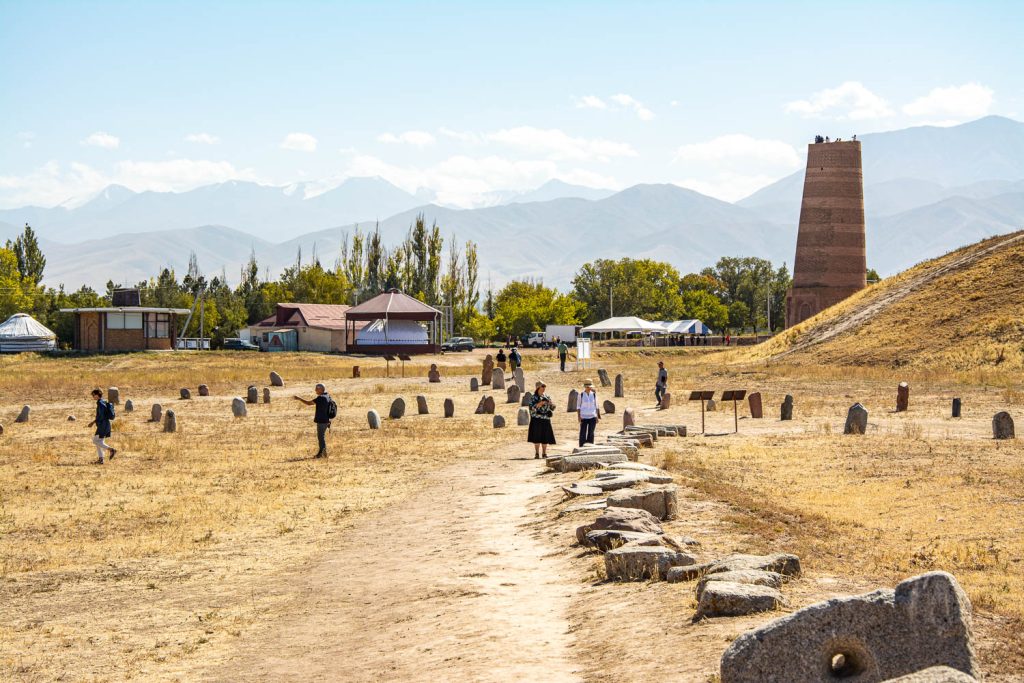
DAY 2. HIKING TO KARAKOL GORGE
Trekking distance/time: 10km, 5-6 hours Ascent: 440 meters
Transfer from Karakol city to the starting point through the lush Karakol Valley with gushing rivers along. Drop off near the bridge where our hike starts towards the lunch spot. Enjoy walking in this gorge with green slopes decorated by evergreen trees. Spot grazing herd of horses beautifying nature. After lunch, we hike in this serene environment up to the Campsite standing at 2550 meters. After camping, take a walk around the area and relax in this solitude area surrounded by spruce trees.
Accommodation: Tent
Meals included: Breakfast, Lunch, Dinner
Facilities: No wi-fi, no electricity, no hot shower, outdoor toilets
Karakol gorge, on the way to Sirota campsite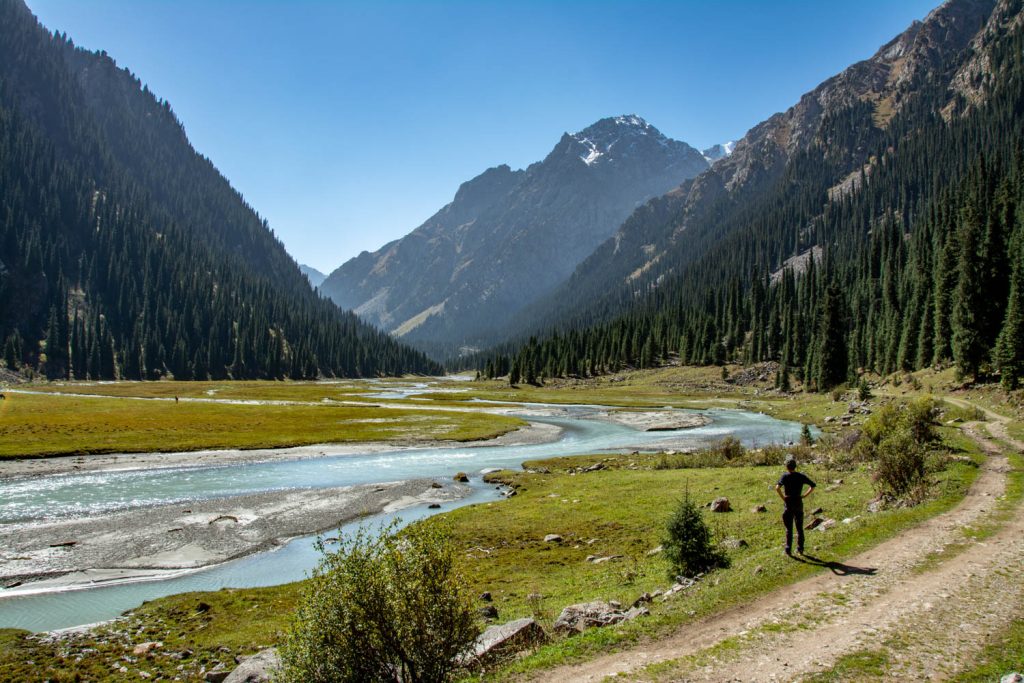
DAY 3. TO ALA KUL LAKE VIA SIROTA HUT
Trekking distance/time: 10 km, 6-7 hours Ascent: +1030m
This day challenges you with strenuous walking through screws and boulders before you get to the lake, 3 hours. After a few hours of demanding ascent, be rewarded with the jewel of Ala Kul Lake standing at 3500 meters and fed by glaciers around. The view of this turquoise alpine lake takes your breath away. Arrival in the campsite. Be accommodated in tents. Free stroll around the lake. Dinner and overnight.
Accommodation: Tent
Meals included: Breakfast, Lunch, Dinner
Facilities: No wi-fi, no electricity, no hot shower, outdoor toilets
Stunning views of Mt. Tian Shan opens up on top of the Ala Kul Pass 3900m
DAY 4. TO ALTYN ARASHAN VALLEY AND HOT SPRINGS OVER ALA KUL PASS
Trekking distance/time: 13 km, 6-7 hours Ascent: – 340m Descend: – 1400m
After breakfast, we head on to our yurt camp along lush green pastures with gently flowing rivers of Altyn Arashan Valley, for 3-4 hours. At some point, you will cross one of the streams, but the level is low. Arrived at our yurt camp standing at 2450 meters. In fact, Altyn-Arashan means ‘Golden Spa’ and this valley is famous for its hot sulfur springs. We take a bath in hot spring pools after three long days of hiking to relieve muscle pains.
Accommodation: Yurt camp
Meals included: Breakfast, Lunch, Dinner
Facilities: No wi-fi, electricity, hot spring, outdoor toilets
Altyn-Arashan valley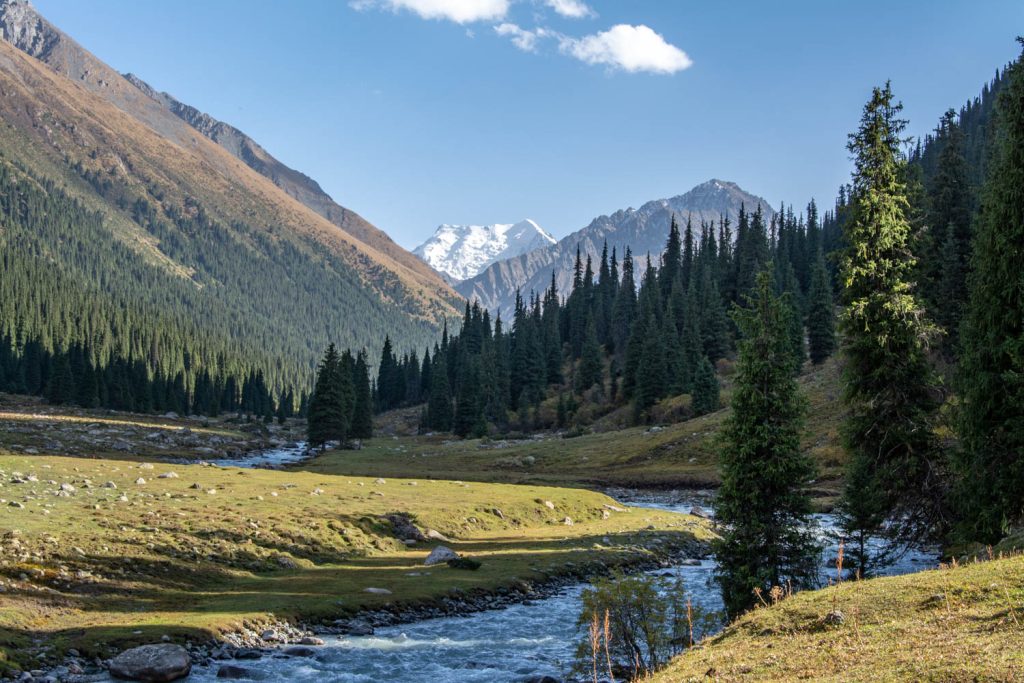
DAY 5. TO AK SUU VILLAGE – KARAKOL CITY – ISSYK KUL LAKE
Trekking distance/time: 10 km, 4 hours Descent: – 450m
Start the hike early morning, after breakfast. The last day of hiking is very easygoing compared to the days before. The trail goes most of the time along a beautiful river gushing through the valley. You will never be able to forget the sight of the snow on Peak Palatka at 5260 m or “Swallow’s Nest Pool”, nestling beneath the open sky. The final stretch, reach Ak Suu village (4 hours) where you will be picked up by our driver to get to Karakol city (30 minutes). Lunch in a local restaurant. Transfer to Bel Tam yurt camp in the southern shore of Issyk Kul lake, 4 hrs drive. On the way stop to explore the magical Skazka canyon. Dinner and overnight in a yurt camp at the lakeshore.
Accommodation: Yurt camp
Meals included: Breakfast, Lunch, Dinner
Facilities: Wi-fi, electricity, hot shower, and western-style toilets
Issyk Kul lake - the pearl of Mt. Tian Shan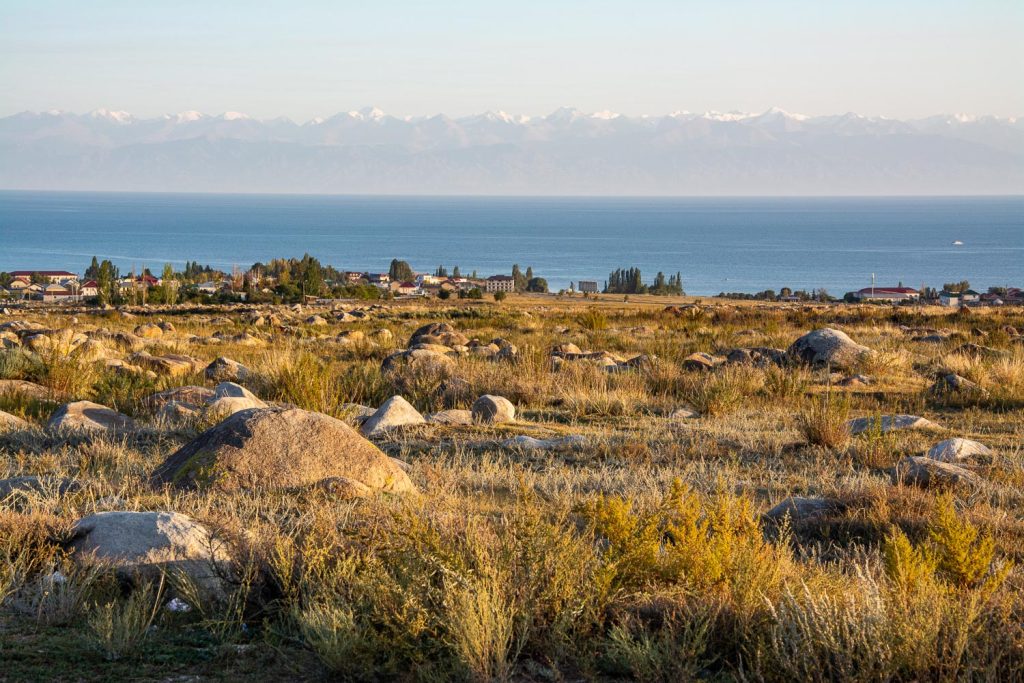
DAY 6. ISSYK-KUL LAKE – SONG KOL LAKE
Driving distance/time: 130 km, 5-6 hours
Today, we drive to Song Kol Lake, one of the largest alpine-mountain lakes in the country and considered a sacred place for many Kyrgyz nomads for its best summer pastures. You can spot nomadic herders and their families tending their goats, sheep, and horses. On the way to Song Kol, you can opt to visit the eagle hunter to see some of his hunting skills (available for 60 USD). Lunch in Kochkor village. In Song Kol we will have the opportunity to sample fresh airan (yogurt) and kumis (the national drink of fermented mare’s milk). After, we will stay in yurts set up along the lakeshore. Sleeping arrangements are on a multi-share, mixed-gender basis with mattresses on the floor. It can get very chilly in the evenings, so there is a stove for heating and plenty of blankets. There are no bathroom facilities inside the yurts – please expect outdoor toilets. Those daring enough for a morning dip can make use of Song Kol.
Accommodation: Yurt camp
Meals included: Breakfast, Lunch, Dinner
Facilities: No wi-fi, no electricity, no hot shower, outdoor toilets
Sunset in Song-Kul lake
DAY 7. SONG KOL TO KAZARMAN
Driving distance/time: 194 km, 7-8 hours
Drive south of the lake to reach Moldo Ashuu Pass. Nice drive on switchbacks. Enjoy the beauty of colorful mountains while driving to Kazarman city. Lunch break en route. Arrival in Kazarman and a short walk in the city. Overnight and dinner in a homestay.
Accommodation: Guesthouse
Meals included: Breakfast, Lunch, Dinner
Facilities: Wi-fi, electricity, hot shower, and western-style toilets
DAY 8. KAZARMAN TO OSH
Driving distance/time: 258 km, 6-7 hours
The highlight of the day is the Kaldama pass. Amazing mountain ranges open up on top of the pass. Descend down the pass. Driving through dense bushes covering the road and mountain slopes delights your senses. Lunch on the way to a café. Arrival in Osh city and accommodation in a hotel. Afternoon walks in the city. Dinner at a restaurant.
Accommodation: Hotel
Meals included: Breakfast, Lunch, Dinner
Facilities: Wi-fi, electricity, hot shower, and western-style toilets
The oldest Bazaar in Osh city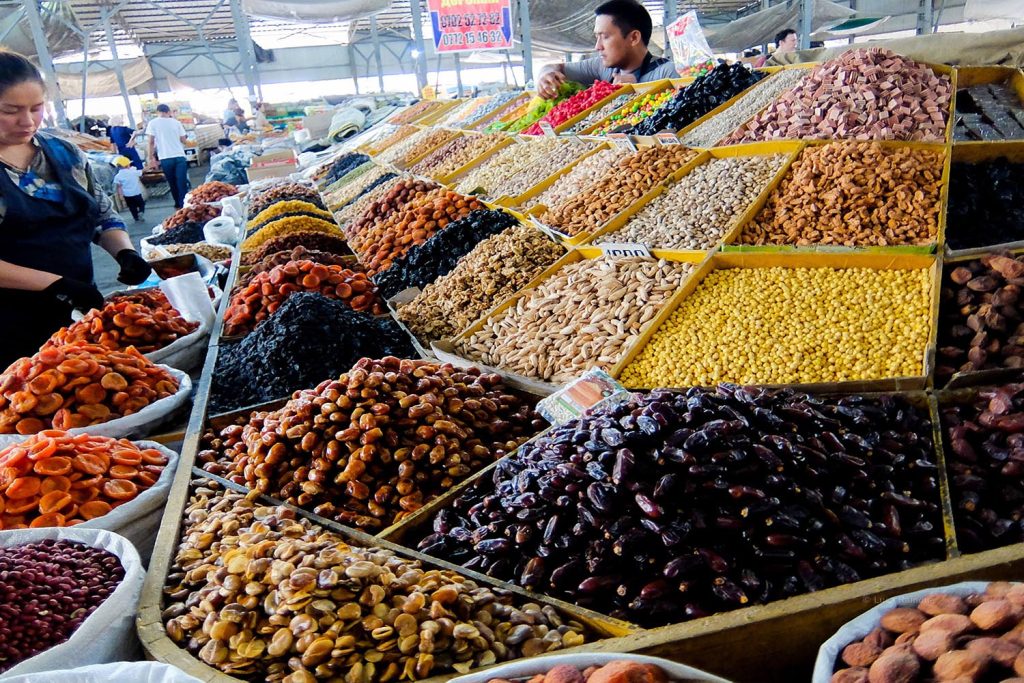
DAY 9. DEPART OSH TO KOJOKELEN
Driving distance/time: 4 hours
Depart from historic Osh City to the village of Kojokelen(2200m), the starting point of the trek. There is remarkable scenery along the way to Kojokelen village so enjoy the ride! After three and half hours of driving, we reach Kojokelen a quiet rural village nestled in the foothills. Before dinner, take a short walk to the beautiful gorge above the village. We will enjoy a home-cooked dinner and an overnight stay at a family-run guesthouse.
Accommodation: Guesthouse
Meals included: Breakfast, Lunch, Dinner
Facilities: Wi-fi, electricity, hot shower, and western-style toilets
Life in Kojokelen village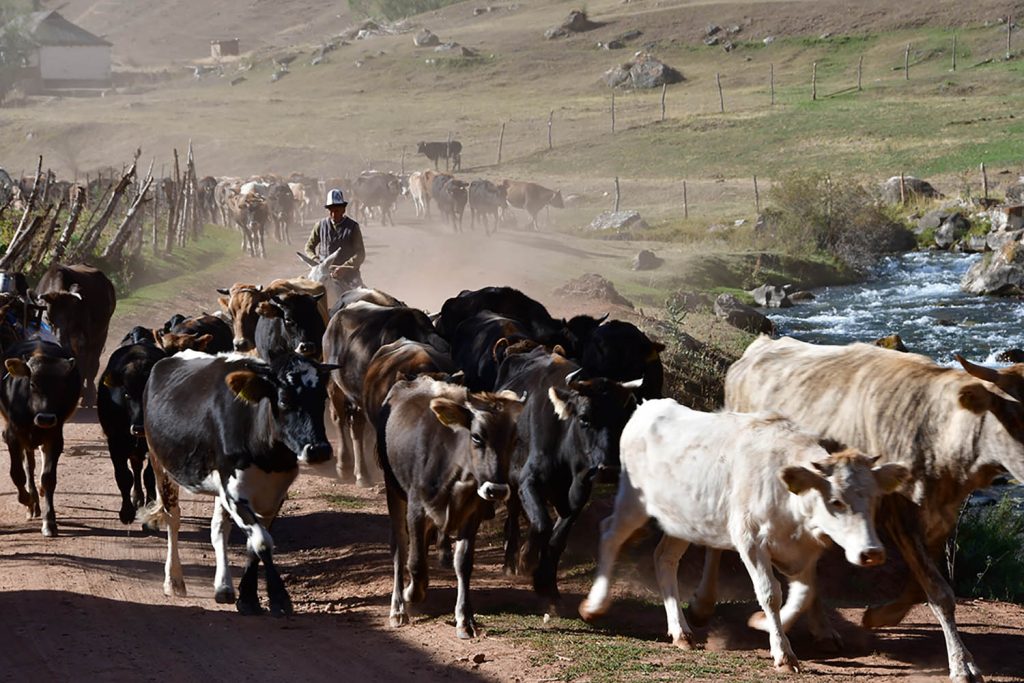
DAY 10. TREK FROM KOJOKELEN VILLAGE OVER SARY BELL PASS TO KOSHMOINOK VALLEY
Trekking distance/time: 12km, 7-8 hours Descent: 412 meters Ascent: 1013 meters
After breakfast, we say “Goodbye” to our hosts and start our trekking by crossing the wooden bridge. We start ascending the uphill for 5 hours with spectacular views of the gorge, and it is the giant red rock formations. The red rock formations forming the “Three Dragon Gorge ”is one of the most beautiful spots in all of Kyrgyzstan. Views of the rugged Kichik Alay Mountains open up on top of the pass. From there, follow the path as it winds along the edge of the hills. You can see the snow-covered Pamir landscapes in the distance with various grades of high-, mid-, and low alpine landscapes along the way. The trail then descends through the evergreen juniper forest into a beautiful Kosh-Moinok valley (40 minutes). Time to rest. Enjoy a home-cooked meal and overnight in a yurt camp at 2,800 meters.
Accommodation: Yurt camp
Meals included: Breakfast, Picnic lunch, Dinner
Facilities: No wi-fi, no electricity, no hot shower, outdoor toilets
Break Time at Sary-Bell Pass 3,132 m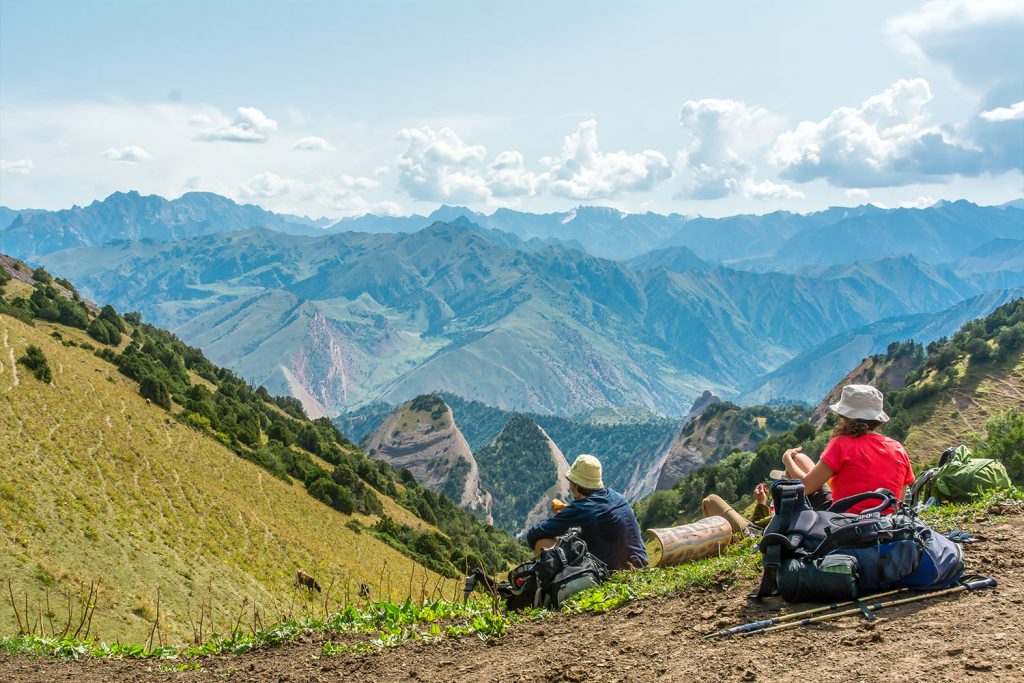
DAY 11. TREK TO BESHKOL CAMP VIA KYZYL SHORO VILLAGE
Trekking distance/time: 20 km, 8 hours Descent: 868 meters Ascent: 1749 meters
The second day is relatively strenuous and uphill. We fuel ourselves with a generous breakfast before setting off. The trail becomes steep and ascends approximately 400 meters through grass meadows, and pastures to Koshmoinok Pass at 3,210 m (1 hour). After the steep sloops, the trail winds its way down through evergreen trees and continues to the edge of the valley until it reaches Kyzyl Shoro village (2 hr). Break for lunch in the village at a homestay. Enjoy a hearty home-cooked meal, charge your devices, and take a quick hot shower. After lunch, almost flat walk until you get to the next village. At this point, the trail turns away to the south, and from the trailhead begins the steep 9 km climb along the well-trodden path through fields filled with grazing cows and shepherd’s yurts inviting you for tea. As the trek progresses through the valley, the trail cuts back and forth across the river several times. With the increase in elevation, the terrain begins to change from mid-mountain green forest to high alpine rocky and dry landscapes. Finally, the Campsite! After 4-5 hours of intensive trekking, we reach our yurt camp. Dinner and overnight in a family-run yurt at 3,600 meters.
Accommodation: Yurt camp
Meals included: Breakfast, Lunch, Dinner
Facilities: No Wi-fi, no electricity, no hot shower, outdoor toilets
*Wi-fi, electricity, and hot shower available during lunch in Kyzyl Shoro village
On the way to Beshkol camp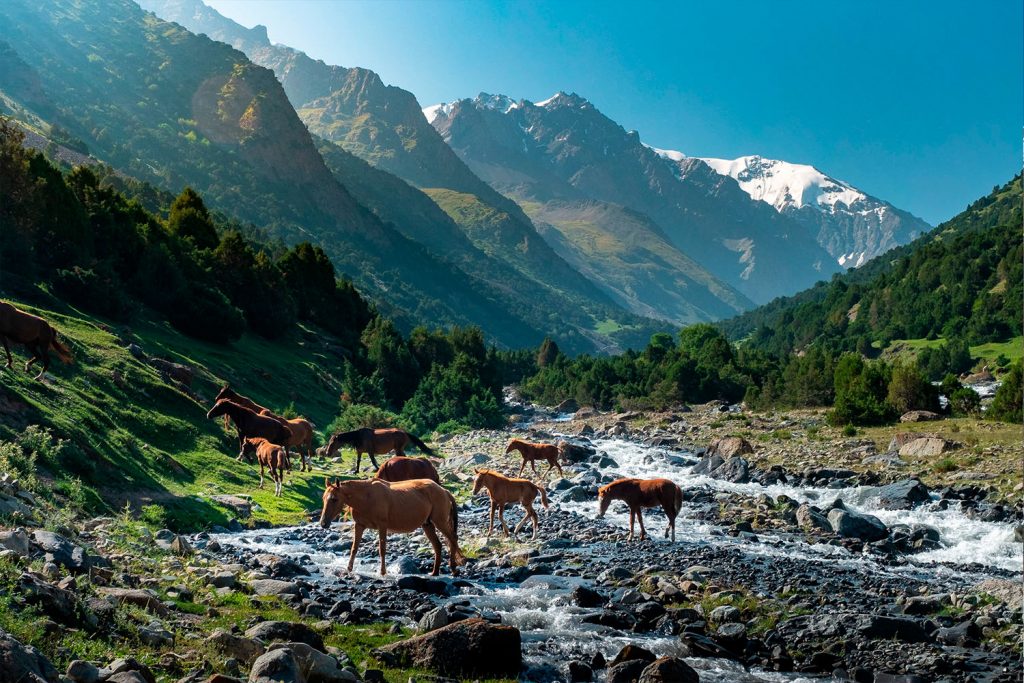
DAY 12. TO SARY-MOGOL VILLAGE OVER SARY MOGOL PASS 4303M
Trekking distance/time: 14 km, 6-7 hours Descent: 1053 meters Ascent: 925 meters
After breakfast, we head to Sary Mogul Pass at 4,306 meters. Walk along the stream all the way up to the foot of the pass (1,5 hours). Head up to the top of the pass on a barely seen trail in a zigzag formation on loose scree (1 Hr). The ascent to the pass is steep and covered in loose scree. As you arrive at the pass, the glaciated peaks and alpine lakes begin to appear. Enjoy your accomplishment at the top of the pass with its otherworldly and stunning views. While descending, some parts of trails are a bit challenging as the trail is narrow and the terrain is composed mainly of scree and small pebbles. We break for lunch at the riverbank with glacier views all around. After lunch, we head into a valley to follow the small stream all the way to a finish point of the trail (2-3 hours). Meet your driver and drive to Sarymogol village (20 minutes). Arrive at your homestay and enjoy a home-cooked dinner. Take a shower, and enjoy your dinner.
Accommodation: Guesthouse
Meals included: Breakfast, Picnic lunch, Dinner
Facilities: Wi-fi, electricity, hot shower, and western-style toilets
Sary-Mogol Pass 4303m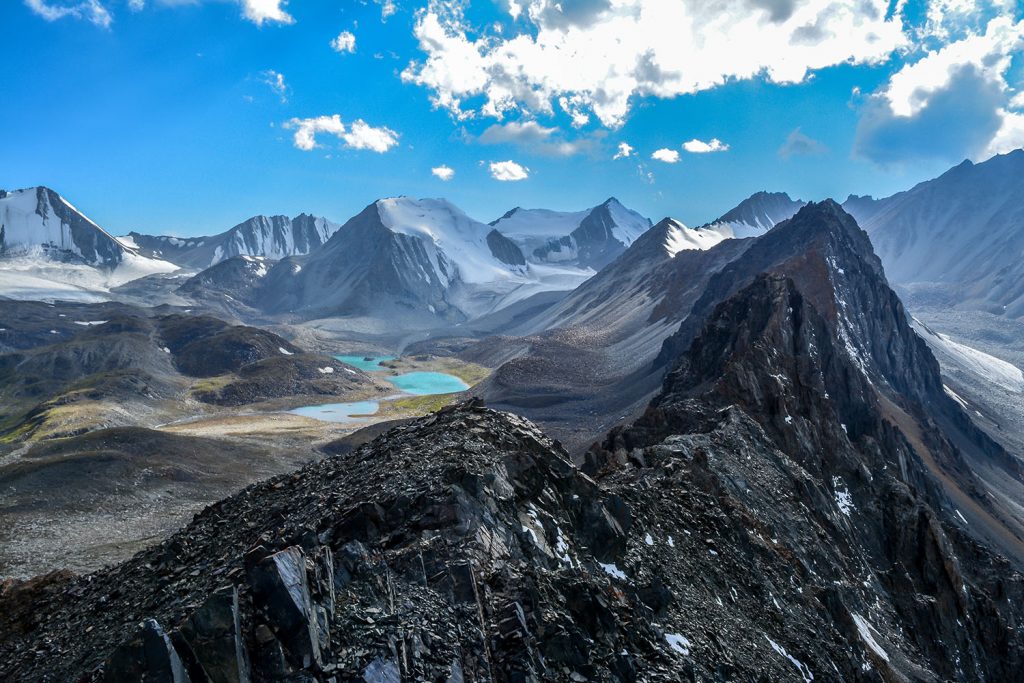
DAY 13. TREK TO TRAVLERS’S PASS (4100 meters)
Trekking distance/time: 20 km, 7-8 hours Descent: 760 meters Ascent: 760 meters
Wake up early. After breakfast, we drive for 50 minutes to get to Tulpar Kul Lake. Arrival, we will head south from Tulpar Kol to the Alpinist Peak Lenin Base Camp. After passing the Base Camp, we will begin the ascent to Traveller’s Pass. The trail goes slowly up except for the last 20 minutes where it becomes a steep zigzag trail that ends up on the Traveller’s Pass at 4,100 meters. Enjoy the magnificent views of glaciers tumbling off the massive peak. Go to the viewpoint on the right of the pass and get an even better view of Lenin Peak at 7,134 meters, the highest peak in this Pamir-Alay Mountains. Break for lunch there. Return to the yurt camp in the same way you came. Overnight and dinner in a yurt camp.
Accommodation: Yurt camp
Meals included: Breakfast, Lunch, Dinner
Facilities: No Wi-fi, no electricity, no hot shower, outdoor toilets
Trekking towards Traveler′s Pass 4150 m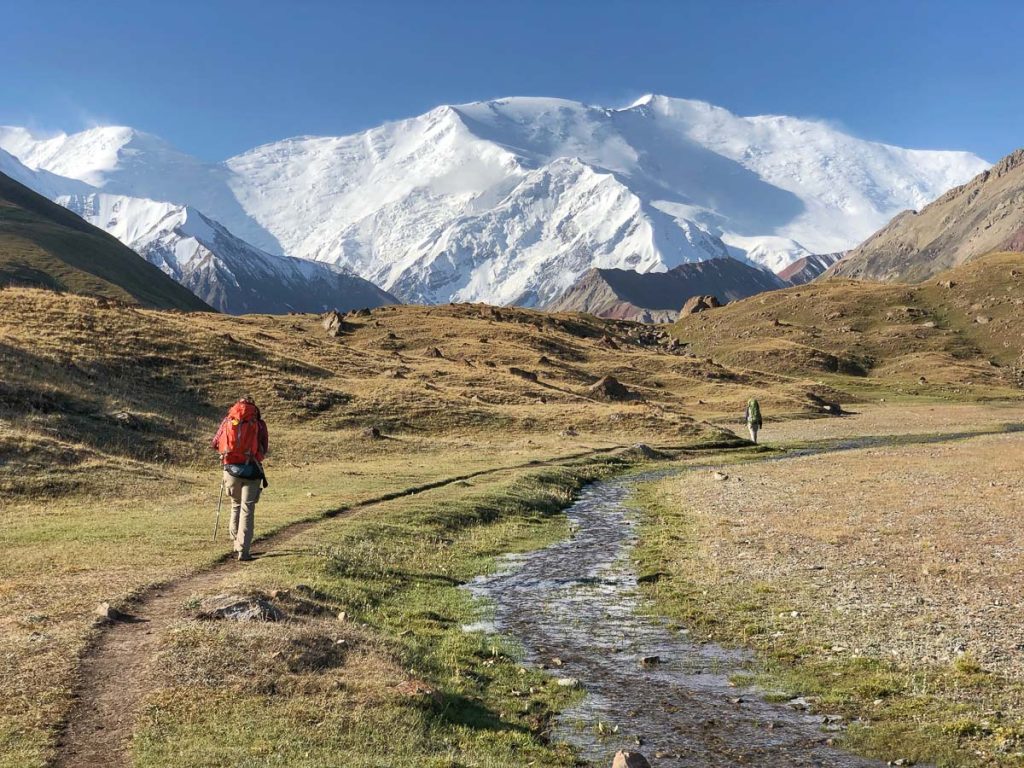
DAY 14. BACK TO OSH CITY
Driving distance/time: 250 km 5 hours
Breakfast. Drive back to Osh city. End of tour.
Meals included: Breakfast
Price for the Best of Kyrgyzstan Trek:
| Number of people | 2 | 3 | 4 – 5 | 6 | 7 | 8 |
| Price per person in USD | 2500 | 2120 | 1960 | 1770 | 1690 | 1570 |
| Included | Not included |
| – All the necessary transportation* – Accommodation:
– Full board meal**: Breakfast, Lunch, Dinner | – Hotels and meals in Bishkek – Alcoholic, soft, coffee, mineral drinks – Tips – Health/Travel insurance – Items not mentioned above – Sleeping bags, mat – Entrance tickets to sightseeing – City tours – Bottled water |
*For groups of up to 4 people, we provide 4×4 vehicles equipped with English-speaking driver. For groups of 5 or more, a mini-bus with english speaking guide will be arranged.
**Please let us know in advance if you are vegetarian/vegan or if you have food allergies.
Join the following groups for summer 2025
If the following dates do not suit your travel plans, please contact us. We will post a new tour with your dates and try to collect more people to join you.
14-day trekking in Kyrgyzstan
What to Expect:
Accommodation on the trek: In small villages, you will be accommodated in a family guesthouse. They are not luxury but we make sure they offer you a truly authentic experience. Expect to share a room with 3-5 people. You will be provided with a bed and warm blankets. Toilets are shared, and often outside. Hot showers are available almost in all of the homestays.
Sleeping in a traditional Kyrgyz yurt is a highlight for many travelers. The yurt nights are on a multi-share basis, normally with 5-6 people and you will sleep on mats on the ground with blankets piled on top. Toilets are outside, so be sure to have a headlamp with you to navigate there at night.
Food during the hike: Most of the meals on this tour are home-cooked and provided by a yurt camp or guesthouse. These traditional Kyrgyz meals usually include some sort of meat (often mutton) served with potatoes, rice, or homemade noodles. Fresh bread rounds are also a must at every meal and you’ll often find homemade jams and traditional sour cream to go with this.
When camping you will also be served a simple hot meal at dinner. Lunch on the trail is usually a picnic made composed of bread, meat, vegetables, fruit, and other snacks.
We are able to cater for vegetarian diets. Please let us know in advance if you are vegetarian/vegan or have food allergies. If your dietary requirements are especially strict, you are advised to bring a sufficient supply of your required food types with you to ensure you are provided for.
Drinking Water: There are clean mountain springs along the trail that are possible to drink, for refilling please bring your water bottles. To avoid any stomach pain or diarrhea you should also carry water purification tablets and water filters. While trekking, boiled or safe drinking water is available to purchase in guesthouses or in yurt camps.
What you carry: In your daypack, you will carry a rain/down jacket, water bottle, camera gear, valuables, and personal items such as sunscreen, lip balm, etc. Horses or porters carry all group gear and your trek pack.
Recommended packing list for the trek:
• Warm clothes and layers as it gets warm during the day, but can go below freezing at night and when it rains • Good trekking shoes • Day pack to carry a camera, water, sunscreen, etc. • Sun protection as the sun is very strong at altitude: Sunglasses, sunscreen (SPF 30 or above), and a sun hat /cap • Water and windproof jacket and pants. It gets especially windy on the mountain passes • Walking sticks are recommended (available at 6 USD per day) • Medical kit for treating blisters, traveler’s diarrhea, and other minor illnesses. • Water purification tablets or drops if you want to clean the spring water • Refillable water bottle • Lip balm: your lips get chapped very easily in the mountains • Wet wipes and/or anti-bacterial gel to clean hands • Hat and gloves to wear at night for warmth • Headlamp to navigate campsite and yurt camps at night • Warm sleeping bag (available at 5 USD per day). Yurts and homestays provide blankets.
Note: we will provide you with a saddle bag to put your gear in it and carry on the horses. While on the trek, the gear should be packed in a rucksack or Duffel Bag, which will be easy to carry by the horses. No suitcase!))
Phone and Internet access:
In general, Kyrgyzstan has excellent internet access throughout the country. All the hotels and most guesthouses in the cities or towns offer free WiFi. However, purchasing a local Sim Card upon arrival in Kyrgyzstan can also be an option. The best mobile service provider in Kyrgyzstan is “MegaCom”. Not only do they have the best coverage in the country, but they also have the most choice in terms of data packs and are relatively cheap. You can find the MegaCom sales offices right at the airport or in the city centers. While trekking WiFi may be available in most guesthouses, but high in the mountains, the phone reception simply does not work. So you should expect to trek for a couple of days without access to the internet. Your tour guide will offer you some advice on when and where you will get a connection.
Please note that during the trek electricity will be available only in the guesthouses so make sure to charge your devices. But no electricity while camping in tents and staying in yurt camps. Past travelers have found portable solar chargers to be very useful.
Weather Information:
The climate in Kyrgyzstan is continental because it is located so far from the ocean, but the general climate of Kyrgyzstan is quite pleasant, with four defined seasons. Although the summer in the cities can get quite hot, at higher altitudes, the temperature remains cool and never reaches very high. Because of heavy snowfall in the winter, many passes and trails can be not accessible, because of it many destinations and trekking paths can only be reached in the summer months. The pleasant weather for trekking season normally starts from early July till the end of September.
On warm summer days, the temperature in the Tian Shan and Alay Mountains might reach up to +20 to +25 degrees during the day, and +10 to +15 at night. But if it rains it will get a bit chilly but not freezing cold. Generally, the weather in July, August, and September is mostly sunny and dry, occasional rainy days should be expected.
Best of Kyrgyzstan Trek Photo Gallery
FAQ: Kyrgyzstan Trekking and Hiking Preparation
Yes, certain border regions of Kyrgyzstan that are close to the Tajik, Uzbek or Chinese borders require special permits to visit. For example, to hike to Lenin Peak Base Camp in the southern Pamir-Alay Mountains near the Tajik border, a Kyrgyz Border Zone Permit is officially required. This permit costs around $15 for the regular application time (1-3 weeks) and $30-$50 for expedited services (e.g., 1-3 days).
Visit Alay includes the application process and cost of the permit (for regular speed applications) as part of the tour cost for treks to Lenin Peak Base Camp or if your tour goes to another location that requires a permit. We ask for a copy of your passport at the time that you book your tour in order to apply for your permit.
If you are going to Lenin Peak Base Camp or another border zone not on one our tours, be sure to apply for your permit several weeks in advance through a local tour company.
Note: Although many travelers visit places like Tulpar Kol Lake and Lenin Base Camp without being checked, we strongly advise that you have the permit to avoid any issues with military border guards.
The difficulty level of our hiking and trekking tours in Kyrgyzstan varies depending on the route, altitude and condition of the trail. Some hikes are suitable for beginners with an easy or moderate level of difficulty, while others are quite challenging and require good fitness levels, prior trekking and hiking experience at altitude.
You don’t need any prior trekking experience. For those treks that are rated medium to difficult this means you should be in decent physical shape and ready for some long hiking days and high-altitude passes. You don’t need technical climbing experience or special equipment; our multi-day treks are essentially extended mountain hikes with no ropes or vertical climbs.
Many of our hikes and treks in the Pamir-Alay Mountains and Tian-Shan Mountains fall into the medium to difficult range, but don’t let this scare you away. Our experienced guides are used to working with trekkers of all backgrounds and we also have luggage horses on many trekking tours that can provide support to go over a mountain pass or a steep ascent.
We recommend that you research the trekking and hiking tours and routes above in detail (each tour page provides the difficulty level, length in km, and maximum elevation) and determine whether it’s suitable for your fitness level and experience. You can always get in touch with us and we can provide advice as to which trek or hike in Kyrgyzstan would suit you best.
It is always a good idea to do some physical training in advance so you can fully enjoy your trek. Cardiovascular fitness and leg strength are the most important. We recommend you start taking regular hikes or long walks in the weeks (or months) leading up to the trip. Gradually increase distance and carry a daypack to simulate the trek conditions. If you don’t have hills nearby, stair climbing or using a treadmill/incline trainer at the gym helps build uphill stamina. Aim to be comfortable walking 5-6 hours in a day.
Be sure to break in your hiking boots ahead of time so that they are comfortable and don’t give you blisters. In other words, don’t arrive with brand-new shoes.
Even if you can’t train much before your trek, don’t worry. Our experienced guides are very patient and will adjust the pace to the group. Having done a bit of prior training, however, will increase your enjoyment and reduce soreness.
We provide a detailed packing list for each trekking tour, but here are the essentials you should bring for mountain treks and hikes:
- Warm clothes and layers as it gets warm during the day, but it can go below freezing at night and when it rains. This means having layers like fleece and light jackets during the day, as well as a down jacket for comfort at night.
- Good hiking shoes. Ankle support is not necessary, but it might be useful to have when going up some of the steep inclines.
- Small day pack to carry a camera, water, sunscreen, snacks, extra clothing layers.
- Sun protection as the sun is very strong at altitude: Sunglasses, sunscreen (SPF 30 or above), and a sun hat /cap
- Water- and windproof jacket and pants. It gets especially windy on the mountain passes and this provides another layer of warmth, in addition to protection from rain.
- Walking sticks are recommended (we can provide for an additional fee if you don’t have them)
- Medical kit for treating blisters, traveler’s diarrhea and other minor illnesses
- Water purification tablets or drops if you want to clean the spring water
- Refillable water bottle as we want to avoid single-use plastics waste in the fragile environments of the mountains. We recommend water bottles with their own filtration and purification like a Grayl Water Bottle or LifeStraw Water Bottle.
- Lip balm: your lips get chapped very easily in the mountains
- Wet wipes and/or anti-bacterial gel to clean hands
- Hat and gloves to wear at night for warmth
- Head lamp to navigate campsite and yurt camps at night
- Warm sleeping bag (you can rent this from us if you don’t have one). Yurts and homestays provide blankets. Some people like to bring a sleeping bag liner with them as well for extra warmth and comfort.
Packing Tip: We advise splitting your gear into a daypack (carried by you) and a duffel/backpack for the pack animal. You can leave any extra luggage in Osh or Bishkek at our office or guesthouse while you trek. On the trail, we provide pack horses or porters to carry the heavy gear (up to 15 kg/person) so you can trek with just a light daypack.
No, you don’t need to bring tents or cooking gear – we provide all communal camping equipment on our organized treks.
Our trekking tours typically include tents, sleeping pads, cooking stove, and utensils when camping is required. Many of our treks in Kyrgyzstan use established yurt camps or homestays each night, so you may not camp every night – but when we do camp, we handle all the gear. You will need to bring your own clothing and personal items, as well as a sleeping bag (you can rent one from us if you prefer). Essentially, you should pack as if you’re backpacking (clothes, boots, etc.), and we’ll take care of the rest: setting up tents, preparing meals, etc. If you have favorite personal gear (like a special lightweight sleeping pad or camp pillow), you’re welcome to bring it, but it’s not necessary. This full support means even if you’re not an experienced camper, you can enjoy nights under the stars without worrying about the logistics.
No, you won’t have to carry everything on your back. All our multi-day treks include pack animal support (usually horses or mules) or porters to transport the heavy gear. We ask that you bring a duffel or backpack that we can strap to the pack horse – typically we allow about 15 kg of personal luggage per person to be carried by the animals.
This is where you put your clothes, sleeping bag, and overnight items. Meanwhile, you’ll carry just a small daypack with the essentials you need during the day’s hike (water, snacks, jacket, camera, etc.). Each morning, you’ll hand over your main bag to our staff who will secure it to the horses and you won’t see it again until we reach camp that afternoon.
By carrying your heavy gear, we ensure that you can hike and trek comfortably without a heavy load, focusing on the stunning mountain scenery rather than the weight of your backpack. It’s also a nice aspect of community tourism as we hire local horsemen and their horses who know the terrain.
Accommodation on our treks is a mix of local homestays, yurt camps, and occasional tent camping depending on the route.
We work with local families and providers so all of our accommodation along the treks and hikes are locally owned and have a personal, local feel to them. They are simple, but clean and comfortable. This also means that the money stays local in that community.
Guesthouses and yurts usually offer shared rooms (3-6 people) with outdoor toilets. The accommodation type may vary depending on the route. Some of our high-altitude treks require camping in tents if there are no yurt stays in the area. Each of the trekking tour descriptions includes the type of accommodation used on that trek.
Overall, while accommodation is rustic on treks, it’s clean and comfortable enough – and part of the adventure of exploring Kyrgyzstan’s mountains.
You will be well-fed on our treks. We provide three hearty meals a day plus trail snacks. One of the benefits of trekking and hiking in the Alay Mountains is that you will have access to delicious homemade Kyrgyz dishes at the different family-run accommodations.
On our trekking tours most of the evening meals are home-cooked and provided by the yurt camp, homestay or guesthouse. These traditional Kyrgyz meals usually include some sort of meat (often beef or mutton) served with potatoes, rice, or home-made noodles for a hearty dinner after a long day of hiking. Fresh bread rounds are also a must at every meal and you’ll often find homemade jams and traditional sour cream to go with this.
Lunch is usually picnic style and served at a beautiful overlook or near an alpine lake. This usually includes meats, vegetables, cheese, and other items that can be used to make sandwiches or light meals.
- Vegetarian or Vegan Food: Vegetarians and vegans are very welcome. We can absolutely accommodate a vegetarian or vegan diet. The homestays, guest houses and yurt stays are able to cook vegetarian and vegan food. Please inform the company and guide in advance in you are vegetarian or vegan so we can make the proper arrangements for the food needed along this tour.
- Gluten, Lactose or other Food Allergies: Please let us know if you have any specific food allergies or preferences about food. We will inform the different accommodation providers and also be sure that the picnic lunches have the right foods.
Yes, our guides will ensure you have access to safe drinking water each day. In the mountains, we often source water from natural springs or streams. However, to be on the safe side, we boil water for you. In camp or at yurts, water for drinking and cooking will be boiled. We recommend that you bring a refillable water bottle or water bladder so that you can fill your bottles with cooled boiled water in the morning. This will also avoid plastic waste in a fragile natural environment.
If you have a particularly sensitive stomach or are concerned about water, we recommend you carry water purification tablets/drops and/or a refillable water bottle with its own filtration and purification like a Grayl Water Bottle or LifeStraw Water Bottle.
Yes, we provide secure storage for any luggage you don’t need on the trek and this service is free for our clients. For instance, if you have a suitcase or extra clothes for after the trek, you can leave them at our Osh or Bishkek office. You can also choose to leave your luggage at your hotel or guesthouse in Osh or Bishkek if that is more convenient for you.
Organized big groups will leave their luggage at the hotel or guest house.
For our standard tours, you don’t need any technical gear or climbing equipment — just your personal clothing and regular hiking gear (see below for this). We provide camping equipment (tents, mats) on trekking tours and riding gear on horse treks. However, depending on your activities, there may be a few extra things to consider bringing:
- Sleeping bag: Recommended for treks for extra warmth and comfort. If you don’t have one, we can rent one to you ($6/day).
- Headlamp/flashlight: Very useful for any tour that has yurt stays or village overnights where there is often limited electricity.
- Power bank: If you have cameras/phones, a portable charger helps on multi-day stretches without power.
- Trekking poles: Optional but very helpful on hikes. We have some for rent, but if you have a favorite pair, bring them.
- Riding helmet: If doing horse riding and you want a helmet. This is not provided as part of our horse tours, but we can try to source one for you.
- Water bottle with filtration and purification: We supply safe drinking water on our tours, but some travelers like to use their own filters for additional protection. Consider something like Grayl Water Bottle or LifeStraw Water Bottle.
- Specific snacks or electrolyte mixes: We provide basic snacks, but if you have special energy bars or electrolyte drinks you like then bring a few along.
- Adapter: Power outlets are European two-pin round plugs (Type C/F) in Kyrgyzstan/Tajikistan, so bring an adapter if your chargers use a different system.
Yes, vegetarians and vegans are very welcome on our treks and tours! We can absolutely accommodate a vegetarian or vegan diet and have a lot of experience in this over the years. The homestays, guest houses and yurt stays are able to cook vegetarian food and will offer more eggs, dairy products (e.g., yogurt, kefir), and vegetables. Vegan eaters will be served more vegetable, fruit and grain options during meals.
Please inform us in advance that you are vegetarian or vegan so we can make the proper arrangements for the food needed along this tour.
Kyrgyzstan is a mountainous country with stunning landscapes filled with snow-covered peaks, turquoise alpine lakes, gorges and lush valleys at every corner. Therefore, there’s no shortage of trekking routes and hiking trails in Kyrgyzstan.
Some popular treks and hikes in Kyrgyzstan include the Ala-Kul and Jeti-Oguz treks in the Tian-Shan Mountains, Altyn Arashan trek, the Best of Alay Mountains and Peak Lenin Base Camp treks in the Pamir-Alay Mountains, and Sary Chelek and Arslanbob in central Kyrgyzstan. Each of these hiking routes has its unique attractions, ranging from glacial lakes and valleys to panoramic views of the mountain ranges.
You can find a listing of our most popular Kyrgyzstan hiking and trekking tours above. We suggest you research the treks and routes in detail to select the best hike and trek that matches your interests, desired difficulty level, length and altitude. You can either book a private tour or join a group tour. Just get in touch with us to find out more or book the trek.
The best time to go trekking and hiking in Kyrgyzstan is during the summer months, from mid-June or early July to early September. During this time, the weather is warm and sunny during the day and not too cold at night. Most importantly, the trails and mountain passes are usually clear of snow during this time.
However, the best time for trekking and hiking may vary depending on the trek you choose. Some hiking routes, like those in the Pamir-Alay Mountains, are at high elevations so snow on the mountain passes and trails can go into July. Lower elevation hikes can be done as early as mid-May or early June, which is a beautiful time when the wildflowers are out in force.
Each of our guided trekking tours in Kyrgyzstan above provide details on the best time to do them.
It’s recommended to have some level of physical fitness for a medium to difficult multi-day trek or hike in Kyrgyzstan as many involve hiking at high altitudes and on steep terrain. A good level of fitness and stamina will help you enjoy the trek and moving slow and steady will help avoid altitude sickness.
The cost of guided trekking tours in Kyrgyzstan varies depending on the duration, route, services included, and quality of guide. It usually ranges between $70 – $175/day, depending upon the group size and transfers needed. All of our guided treks and hikes include an experienced English-speaking guide, transportation, accommodation, meals, and luggage transfer (on horses).
You can choose to book a private trekking tour, but if you are on a budget we recommend that you try to join one of our group tours as this will reduce the costs considerably. You can find the prices for each of the treks above depending upon group size in tour details.
Yes, there are a few cultural considerations to keep in mind when hiking and trekking in Kyrgyzstan in order to be respectful of local people, culture and traditions. For example, be sure to remove shoes before entering a yurt or a home. Additionally, always ask for permission before taking photographs of people, their animals and their belongings.
If you visit a mosque or other religious place, it’s essential to dress modestly and for women to cover their heads.


